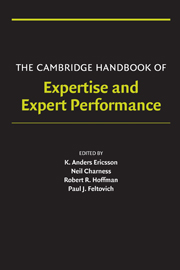Book contents
- Frontmatter
- Contents
- Acknowledgments
- Contributors
- PART I INTRODUCTION AND PERSPECTIVE
- PART II OVERVIEW OF APPROACHES TO THE STUDY OF EXPERTISE – BRIEF HISTORICAL ACCOUNTS OF THEORIES AND METHODS
- PART III METHODS FOR STUDYING THE STRUCTURE OF EXPERTISE
- 8 Observation of Work Practices in Natural Settings
- 9 Methods for Studying the Structure of Expertise: Psychometric Approaches
- 10 Laboratory Methods for Assessing Experts' and Novices' Knowledge
- 11 Task Analysis
- 12 Eliciting and Representing the Knowledge of Experts
- 13 Protocol Analysis and Expert Thought: Concurrent Verbalizations of Thinking during Experts' Performance on Representative Tasks
- 14 Simulation for Performance and Training
- PART IV METHODS FOR STUDYING THE ACQUISITION AND MAINTENANCE OF EXPERTISE
- PART V DOMAINS OF EXPERTISE
- PART VI GENERALIZABLE MECHANISMS MEDIATING EXPERTISE AND GENERAL ISSUES
- Author Index
- Subject Index
- References
10 - Laboratory Methods for Assessing Experts' and Novices' Knowledge
from PART III - METHODS FOR STUDYING THE STRUCTURE OF EXPERTISE
- Frontmatter
- Contents
- Acknowledgments
- Contributors
- PART I INTRODUCTION AND PERSPECTIVE
- PART II OVERVIEW OF APPROACHES TO THE STUDY OF EXPERTISE – BRIEF HISTORICAL ACCOUNTS OF THEORIES AND METHODS
- PART III METHODS FOR STUDYING THE STRUCTURE OF EXPERTISE
- 8 Observation of Work Practices in Natural Settings
- 9 Methods for Studying the Structure of Expertise: Psychometric Approaches
- 10 Laboratory Methods for Assessing Experts' and Novices' Knowledge
- 11 Task Analysis
- 12 Eliciting and Representing the Knowledge of Experts
- 13 Protocol Analysis and Expert Thought: Concurrent Verbalizations of Thinking during Experts' Performance on Representative Tasks
- 14 Simulation for Performance and Training
- PART IV METHODS FOR STUDYING THE ACQUISITION AND MAINTENANCE OF EXPERTISE
- PART V DOMAINS OF EXPERTISE
- PART VI GENERALIZABLE MECHANISMS MEDIATING EXPERTISE AND GENERAL ISSUES
- Author Index
- Subject Index
- References
Summary
Introduction
Expertise, by definition, refers to the manifestation of skills and understanding resulting from the accumulation of a large body of knowledge. This implies that in order to understand how experts perform and why they are more capable than non-experts, we must understand the representation of their knowledge, that is, how their knowledge is organized or structured, and how their representations might differ from those of novices. For example, if a child who is fascinated with dinosaurs and has learned a lot about them correctly infers attributes about some dinosaurs that was new to them by reasoning analogically to some known dinosaurs (e.g., the shape of teeth for carnivores versus vegetarians), we would not conclude that the “expert” child has a more powerful analogical reasoning strategy. Instead, we would conclude that such a global or domain-general reasoning strategy is available to all children, but that novice children might reason analogically to some other familiar domain, such as animals (rather than dinosaurs), as our data have shown (Chi, Hutchinson, & Robin, 1989). Thus, the analogies of domain-novice are less powerful not necessarily because they lack adequate analogical reasoning strategies, although they may, but because they lack the appropriate domain knowledge from which analogies can be drawn. Thus, in this framework, a critical locus of proficiency lies in the representation of their domain knowledge.
- Type
- Chapter
- Information
- The Cambridge Handbook of Expertise and Expert Performance , pp. 167 - 184Publisher: Cambridge University PressPrint publication year: 2006
References
- 83
- Cited by



